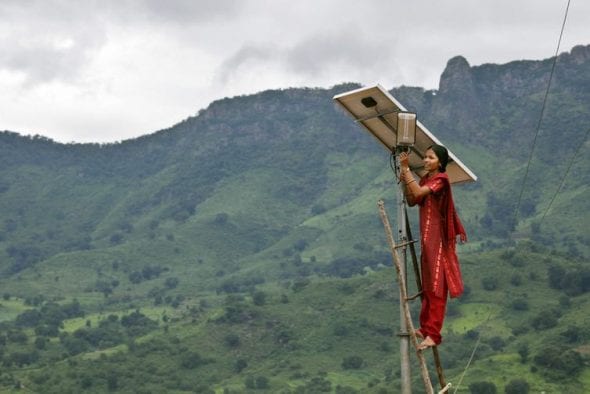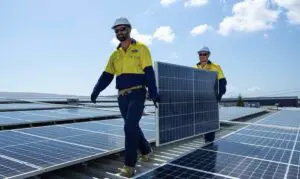Over the weekend the cost of producing solar in Mexico plunged to a new world record low.
Italian company Enel Green Power SpA, the renewable-energy unit of Europe’s largest and most successful utility will build a solar park in Mexico contracted to supply electricity at a world record low price of just US$18 per megawatt hour (MWh).
Earlier this month Chile announced its own record low solar tariff awards at US$22/MWh.
We are clearly heading into a rapidly decarbonizing global energy system at a rate that has been previously unimaginable.
The Institute for Energy Economics and Financial Analysis (IEEFA) has been analyzing the rapidly decarbonizing Indian economy for many years now.
The last two years has seen a 50% decline in both wind and solar tariffs to a record low US$38/MWh in 2017, more than 20% below the cost of existing domestic thermal power generation tariffs.
Many commentators have commented on the energy market disruption that has resulted and questioned if these record low renewable energy tariffs in India can be sustained or replicated.
What has happened in Mexico and Chile, two countries that have also has seen solar costs fall by more than 50% in less than two years gives proof that in the medium these Indian tariffs are not just sustainable, but likely to see even further deflation.
New modeling by IEEFA predicts that India is also within a decade of peak coal demand for the power sector. This is sooner than anyone has predicted. Under this scenario, Australia’s thermal coal export sector is set to take another hit.
IEEFA’s report, “Indian electricity sector transformation”, presents a sector model out to 2027 that sees a transforming energy market with a dramatic market share gain by renewable energy. This in turn delivers sustained energy sector deflation.
By comparison, the International Energy Agency (IEA) World Energy Outlook 2017 forecasts India’s coal use will continue to expand, doubling by 2040 in its New Policy Scenario.
With such exceptional demand growth projected, the IEA assumes that even with a 150% increase in domestic Indian coal production, coal imports will reverse direction and rise by a third from current levels by 2040.

In light of the continued decline in renewable energy tariffs, IEEFA would challenge IEA’s coal centric view of the world as entirely out of touch with energy developments in India under Prime Minister Narendra Modi.
While IEEFA forecasts are non-consensus, it was only in 2016 that the IEA acknowledged China’s use of coal peaked in 2013.
This was 17 years earlier than IEA’s 2030 forecast released just two years earlier. In our 700 page global coal demand and supply report prepared in conjunction with the UK’s Carbon Tracker Initiative, IEEFA called this peak in 2014.
India’s national decarbonisation policy is in line with a global trends which is seeing renewable energy infrastructure investment running at 2-3 times the level of new fossil fuel capacity investment since 2011.
India is on track to catalyse US$200-300bn of new investment in renewable energy infrastructure over the coming decade, and IEEFA expects global capital inflows will play an increasingly important role.
From the international banking sector, investors include Japan’s Softbank and Taiwan’s Foxconn, which have together made a US$20bn commitment to Indian solar power, as well as Goldman Sachs, JP Morgan, Singapore’s Government Investment Corp, Abu Dhabi Investment Authority, Global Infrastructure Partners, Morgan Stanley Infrastructure Partners and Macquarie Group.
Overseas electric utilities are also now active in the Indian renewables space, including Engie and EDF of France, Fortum of Finland and Enel of Italy.
Dutch asset manager APG, and Canada’s largest pension fund managers are also participating in Indian renewable infrastructure transactions. Brookfield, Canada’s largest infrastructure asset manager, is actively seeking new renewable energy opportunities in India.
Global development banks also have been increasingly active in funding renewable energy, supporting infrastructure (e.g. solar industrial parks) and grid development programs, with significant new investments in India by the World Bank, the Asian Development Bank, the European Investment Bank and KfW of Germany.
Indian renewables are also accessing the global capacity of the rapidly growing green bond market. To date in 2017, Indian renewable firms have raised US$3bn in green bonds, doubling India’s cumulative issuance to more than US$4bn.
While there are significant emissions reduction and pollution benefits in India from this clear and consistent energy policy, the strength comes from the fact that it is the economically sensible path: renewable energy is now the least cost solution to deliver sustainable growth for India.
As the world’s second-largest producer, consumer and importer of thermal coal, how India will meet a doubling of its electricity needs in the coming decade will have a major impact on global energy markets. It is now the third largest electricity user in the world behind only China and the U.S.
IEEFA modeling also shows that thermal coal imports not only peaked in 2014/15, and are set to drop two-thirds over the coming decade. India is Australia’s sixth biggest thermal coal export market and so there is clear message closer to home: the stranded asset risk of the Australian thermal coal export sector is significant. Our report can be read here.
The economics are inarguable. While IEEFA has consistently said that Adani’s proposal to import coal from the proposed Carmichael mine is too expensive and uncompetitive in the domestic Indian market, a shrinking timeline for peak thermal coal demand accentuates this point. Carmichael provides a dirty, expensive import coal source that India has made clear it no longer needs.
This idea, that India could be at or even near peak coal demand, would have seemed laughable just a couple of years ago. But technology and financial developments means this is no longer the case. The challenges to integrating India’s 40% renewable energy target by 2030 are real, but the momentum over the past three years, gained through a clear and transparent government policy plus growing economic merit, gives us confidence India will stay the course. Peak coal in India is in sight.
Tim Buckley is director Energy Finance Studies Australasia at IEEFA.








